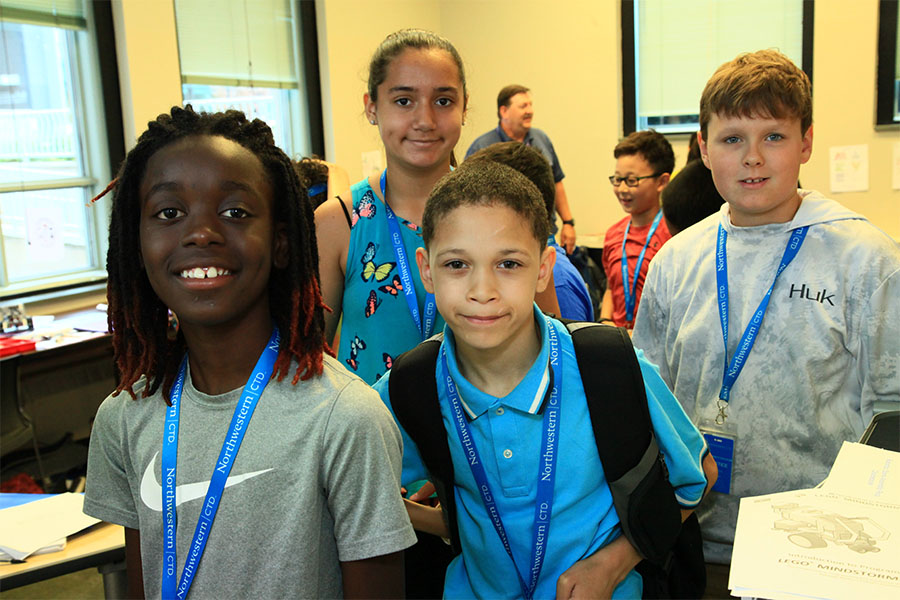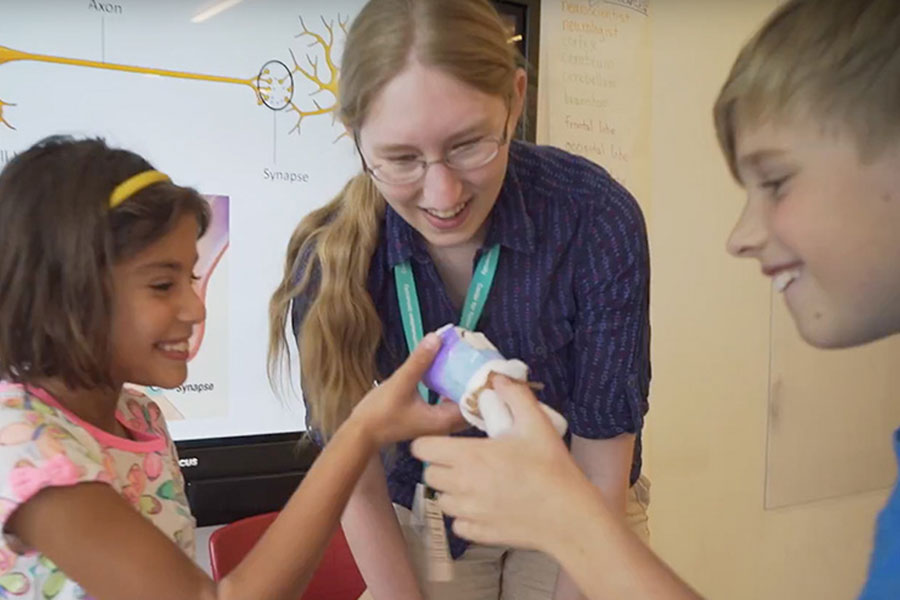Economist’s Research Examines How Tutoring Can Help Kids Catch Up
His methods and findings parallel work at CTD on benefits of frontloaded and targeted enrichment programming
By Ed Finkel
Jonathan Guryan always loved school, from the first day of kindergarten, and in a sense he’s never left. And part of his work now involves helping to instill a love of learning in others.
“I remember coming home [from that first day] and thinking, ‘I want to go back,’ ” says Guryan, Lawyer Taylor Professor of Education and Social Policy and chair of the Institute for Policy Research’s Program on Education Policy at Northwestern University’s School of Education and Social Policy (SESP). “I just love learning, and I like where learning happens. … I went to college, I went straight from college to graduate school, and went straight from graduate school to being a professor. I go to school every day. And I study schools.”
Along his educational pathway, Guryan developed a constellation of interests in history, policy, and inequality, especially racial inequality. A math lover in high school, he started taking economics classes as an undergraduate at Princeton, “and I realized that it was a way to connect learning math to things that were happening in the real world that I was also interested in,” he says. “And I happened to go to college at a place that had a group of labor economists who were really amazing, who studied … public policy, and the minimum wage, and education, and racial inequality.”
Guryan received a PhD in economics from MIT in 2000. Though Guryan’s primary roles are within SESP, he has appointments with both the Kellogg School of Management and the economics department within the Weinberg College of Arts and Sciences. His research spans education policy, labor markets and social interaction. One of his current major strains of research delves into discrimination in labor markets, while the other focuses on bringing individualized instruction into schools via intensive tutoring programs.
“We’ve studied [intensive tutoring interventions] at different schools and found these programs to be very effective ways to help kids, to give kids opportunities to learn at their own pace,” he says. “And so now, a lot of what I’m doing is to try to figure out ways to expand that, so that more kids can benefit from it in ways that are affordable for school districts to give it to more kids, so they could be implemented at larger scales.”
Consistent with CTD research into opportunity gaps for students and how targeted, supplemental enrichment programming can help students accelerate their learning, Guryan’s research has centered around tutoring programs in which groups of two to four students meet for one school period per day, enabling tutors to meet kids where they are in whichever subject they are discussing.
“[The program] allows the tutors to individualize and personalize,” he says. “If it’s math, it’s what problems they’re working on, what topics they’re working on, and different ways of explaining things and working on problems, in a way that’s really hard in the classroom with, say, 25 or 30 kids and one teacher,” he says. “The kids who are in this tutoring program tend to increase their math learning at rates that are on the order of an extra year or two … above and beyond what kids are normally learning.”
This increase occurs whether students were behind, ahead of, or on par with their classmates, Guryan says. “It seems to be really beneficial for all types of learners, and for kids who are at all different points, which is consistent with the idea that everyone can learn math if you go to the place where they are right now, and work with them,” he says. “When you do that, kids spend more time doing math problems. And when you do a lot of math problems over a long period of time, you learn a lot of math.”
The SAGA Education program, which Guryan worked with early in his research in this area, provides “high-dosage” tutoring to districts around the country. The program assesses where kids are in their subject matter knowledge and inculcates a curriculum that spans grades and topics, prompting tutors to start wherever the student is ready to begin learning.
“A kid who hasn’t mastered some topic, who is maybe a couple grades behind where they are in school, the tutor will spend time with them on that topic and progress up to the curriculum as the kids master the material,” he says. “And a kid who has already mastered the stuff that they’re doing in the regular grade-level math class, based on the assessment, they will go and work on things that are farther ahead in the curriculum.” All students also spend time on whatever is being taught in their regular math class at the same time, “so that when they go back into that room, they get more out of what’s happening in that class,” he adds.
Instruction aligned to readiness is an evidence-based practice for all learners, and the more access students have to this type of instruction, the greater their achievement. But when is supplemental, targeted instruction is most effective? From a talent development perspective, the emphasis has been on frontloading of rigorous learning, providing enriched academic experiences to students, particularly students from under-resourced or marginalized communities, in the early grades through middle school.
For example, Project Excite, a collaboration between Evanston schools and Northwestern's CTD, aimed to close opportunity and excellence gaps for underrepresented students in math and science. By identifying and nurturing talent in these areas from third grade onwards, through enrichment activities, supplemental classes, and mentorship, it prepared students for advanced high school courses and fostered long-term academic success. Researchers found that participants consistently performed at high levels and more closely matched the performance levels of white, Asian, and non-low-income peers (Olszewski-Kubilius et al., 2017).
While early investments in elementary education of the sort that CTD often works with schools to infuse can certainly pay off handsomely, Guryan pushes back against those in the education field who believe that programs aimed at adolescents who have fallen behind the academic curve come “too late” and can’t possibly help them catch up to their peers or even help them accelerate beyond grade-level benchmarks.
“I think that logic is flawed,” he says. “Based on the evidence that we’ve gathered on testing effectiveness of programs for adolescents and high school kids, there can be huge returns and huge benefits for kids who haven’t had the opportunities and investments in them that other kids have had. I certainly am sympathetic to the argument that it’s complementary. … We don’t have to decide between one form or the other. Both are good investments that have huge benefits for people and huge societal returns.”
School-aged children and teens learn at different paces in different ways, and K-12 education is often organized around uniformity in how and how quickly students are expected to learn different topics as they progress through the standard grade-level structure, Guryan says. “And certainly, many teachers and many schools do things to try to differentiate and individualize. And that’s part of what a great teacher can do, is reach different kids who have different needs and are ready for different things in the same room,” he says. “That can be hard. But there are ways. The high-dosage tutoring is one of those ways.”
The results speak for themselves, Guryan says. “Many of the classroom teachers in the schools where we’re working will tell us that the kids who spend time in the tutoring room will then come into the classroom more ready to learn,” he says. “And many of the kids who have been struggling because they hadn’t mastered topics they covered a couple grades earlier, now that they’ve started to master those topics, can engage in the grade-level material in ways that make it so that the classroom teacher can reach more kids, and engage more kids.”
The research on targeted, supplemental instruction is encouraging and largely consistent, whether it is aimed at students who have fallen behind grade-level benchmarks or those who have demonstrated potential to achieve well beyond grade-level. From CTD’s talent development perspective, the goal is to help educators and school administrators create a continuum of services that ensures students’ needs are met through interventions in the classroom or through supplemental services.
Paula Olszewski-Kubilius, Saiying Steenbergen-Hu, Dana Thomson, and Rhoda Rosen, “Minority Achievement Gaps in STEM: Findings of a Longitudinal Study of Project Excite,” Gifted Child Quarterly 61, no. 1 (2017): 20–39, https://doi.org/10.1177/0016986216673449.

